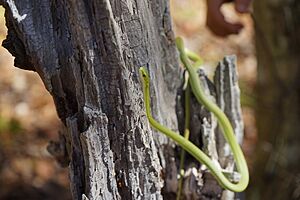Rough green snake facts for kids
Quick facts for kids Opheodrys aestivus |
|
|---|---|
 |
|
| Opheodrys aestivus, rough green snake | |
| Conservation status | |
| Scientific classification | |
| Genus: |
Opheodrys
|
| Species: |
aestivus
|
| Synonyms | |
|
|
The Opheodrys aestivus, also known as the rough green snake, is a common snake found in North America. It is a colubrid snake, which means it belongs to a large family of snakes. This snake is completely nonvenomous, so it is not harmful to humans.
Sometimes, people call it a "grass snake." However, this name is more often used for another snake called the smooth green snake (Opheodrys vernalis). There's also a European snake called the grass snake (Natrix natrix), but it's not related to the rough green snake. These snakes are usually calm and let people get close. They rarely bite, and even if they do, it's harmless because they have no venom.
Contents
What Does the Rough Green Snake Look Like?
The rough green snake is bright green on its back. Its belly is a yellowish color. This coloring helps it blend in perfectly with green plants. It's very hard to spot them in nature, even though they are quite common.
This snake has special scales on its back called keeled dorsal scales. These scales have a ridge down the middle, making them feel rough. They are arranged in 17 rows around the middle of its body. The rough green snake can grow up to about 116 centimeters (45 inches) long. It is also very thin, like a long, green stick.
Where Do Rough Green Snakes Live?
Rough green snakes live across the Southeastern United States. You can find them from Florida all the way north to coastal Maine and Indiana. They also live west to Central Texas. These snakes are common in areas like the Piedmont and the Atlantic coastal plain. However, they don't live in the high parts of the Appalachian Mountains. You can also find them in northeastern Mexico, in states like Tamaulipas and eastern Nuevo León.
Habitat and Behavior of Rough Green Snakes
Rough green snakes love to live in damp meadows and forests. They are often found near water. These snakes spend a lot of their time climbing in trees and bushes. This is why they are called arboreal, meaning they live in trees. They are also good swimmers.
Even though they love climbing, you can sometimes find them on the ground too. Unlike many snakes that are active at night, rough green snakes are mostly diurnal. This means they are active during the day.
What Do Rough Green Snakes Eat?
The rough green snake's diet mainly consists of insects. They also eat other small creatures with exoskeletons, called arthropods. Sometimes, they will eat snails and small tree frogs. These snakes do not squeeze their prey like some other snakes. Instead, they grab their food and swallow it whole while it's still alive.
Who Hunts Rough Green Snakes?
Many animals hunt rough green snakes. Birds are common predators. Other snakes also prey on them. For example, the eastern racer (Coluber constrictor) and the eastern king snake (Lampropeltis getula) will eat rough green snakes.
Reproduction and Life Cycle
Rough green snakes usually breed in the spring. Sometimes, they will breed again in the fall. A female snake will lay between 2 and 14 eggs. Sometimes, several females will lay their eggs together in a shared nest. As many as 75 eggs have been found in one of these shared nests!
They choose different places for their nests. They might lay eggs under old boards, under bark in rotting tree stumps, in deep piles of leaves (mulch), or under rocks. Baby snakes from spring breeding usually hatch in August or September. When they hatch, they are about 18 to 20 centimeters (7 to 8 inches) long.
Conservation Status of Rough Green Snakes
Overall, the rough green snake is not considered to be in danger. It is found in many places. However, some things can reduce their numbers. When cities grow, they often remove plants near water, which takes away the snakes' homes. Many rough green snakes are also hit by cars on roads.
They can also be harmed by pesticides. These chemicals are used to kill the insects that the snakes eat. When rough green snakes die, their green color changes to blue. These snakes are also popular as pets in North America. Hundreds are collected each year to be sold in pet shops.
Subspecies
- Opheodrys aestivus aestivus (Linnaeus, 1766) – This is known as the northern rough green snake.
- Opheodrys aestivus carinatus Grobman, 1984 – This is known as the Florida rough green snake.
Images for kids





